Towel Day Special: A Cemetery Memoir Sneak Peek
Penguins, bikers & memento mori in London's Highgate cemetery!
Keep scrolling to read an excerpt from my forthcoming book!
Every year on May 25, fans across the globe celebrate Towel Day. It’s a tribute to the late, great Douglas Adams, author of The Hitchhiker’s Guide to the Galaxy. It’s a day to carry a towel (the most useful item in the universe, according to Adams) and reflect on his absurd take on life, death, and everything else.
In honor of Towel Day, I’m sharing an excerpt from my upcoming memoir, Around the World in 80 Graves: Travel, Tombstones & Transformation. This chapter recounts my pilgrimage to London’s Highgate Cemetery, where I visited Adams’ grave, left a pen in tribute, and found myself surrounded by punk icons, Egyptian symbolism, and a surprising pair of penguins.
So whether you’re a Douglas Adams fan, or just curious about what penguins are doing on a gravestone, I invite you to read this excerpt from my upcoming book — Around the World in 80 Graves:
BOOK EXCERPT: A Hitchhiker’s Guide to Highgate (from “Around the World in 80 Graves”)
“I may not have gone where I intended to go, but I think I have ended up where I needed to be.”—Douglas Adams
The day I visited Highgate Cemetery felt like something straight out of a Douglas Adams novel: equal parts profound and absurd. Nestled in the rolling green hills of north London, Highgate is one of the city’s most iconic Victorian garden cemeteries. It’s also part of the so-called “Magnificent Seven” which is a group of sprawling burial grounds established in the 1830s and ’40s to relieve overcrowded, unsanitary churchyards. (The nickname for these burial grounds we coined in the 1980s by architectural historian Hugh Meller as a playful nod to the classic Western film of the same name.)
Each of the seven cemeteries was built on the then-outskirts of the city, designed as a park-like alternative to the cramped graveyards of central London. These burial grounds were not just places of interment but destinations for Sunday strolls, quiet contemplation, and even courting couples. Highgate, in particular, with its winding paths, dramatic tombs, and lush greenery, quickly became the most fashionable of them all.
My visit started at the gates, where the crowd was thick with tourists and day-trippers. But once inside, the noise faded into birdsong and the soft crunch of gravel paths. Highgate is a Garden Cemetery in the truest sense, with 37 acres of winding trails, ivy-choked statuary, and Victorian grandeur in various states of decay. It’s easy to get lost here, and honestly, that’s part of the fun. Getting lost in a cemetery might feels like wandering through a forgotten novel, the pages grown mossy and green.
We followed our guide into the older, western side of the cemetery, eventually passing through Egyptian Avenue. This is a breathtaking corridor of family vaults framed by towering stone walls carved to evoke ancient Egyptian architecture. The Victorians were intrigued with Egyptian symbolism, associating it with eternity and the afterlife, and nowhere is that more apparent than this solemn, shadowy passage. Walking through it felt like entering a pharaoh’s necropolis, complete with timeworn hieroglyphs and the hush of ages.
Above it all stood a cedar of Lebanon, a magnificent tree that had anchored the landscape for nearly two centuries. Its massive roots were so entwined with the catacombs beneath that they’d shaped the terrain itself, forming a ring of vaults known as the Circle of Lebanon.
The cedar was still alive during our visit. It was a towering tree, fragrant, and full of presence. You could almost hear it breathing. Sadly, I later learned that the old cedar has since been cut down. Disease and decay made it unsafe, but I’m grateful I saw it while it was still standing. That tree had watched generations of Londoners mourn, remember, and move on. It had become part of the story.
Highgate is full of famous and infamous burials, and I was eager to see more than just one. Among the many graves I sought out was that of Douglas Adams, the beloved British author best known for The Hitchhiker’s Guide to the Galaxy. That book begins with Earth being demolished to make way for a galactic bypass—absurd, but deeply human in its satire and insight. Adams had a knack for distilling the universe's chaos into something hilarious and oddly comforting.
Our tour group that day was a curious mix: my stepdaughter, myself, and a gang of leather-clad British bikers. They were decked out in skull-covered jackets and leather boots, but despite their rough-and-tumble look, they were a jovial bunch. As we made our way past weeping angels and crumbling obelisks, I couldn’t help but laugh at the irony: here we were in a place filled with memento mori, while these guys were wearing theirs. It was as if the Grim Reaper had sponsored a motorcycle club. [Memento mori, as I explain earlier in the book, are artistic or symbolic reminders of mortality—like skulls, hourglasses, or even wilting flowers.]
It was such an Adams-esque moment—serious and silly all at once.
We saw several notable graves along the way. Malcolm McLaren’s headstone caught my eye first. He was the infamous manager of the Sex Pistols, the punk provocateur who helped launch an entire movement. His grave is bold, just like the man himself, unapologetically brash, and proud of it, with an epitaph that states: “Better a spectacular failure than a benign success.”
Not far away is the monument to Karl Marx, unmistakable thanks to the imposing bust of his bearded head perched atop a granite plinth. It doesn’t whisper sentimentality; it declares ideology. His epitaph is perfectly on brand: “Workers of all lands unite.” No Victorian euphemisms about peaceful slumber here!
Then there was Jeremy Beadle. I didn’t know who he was, but I immediately liked his grave marker. Shaped like a shelf with a row of neatly carved books, it features a playful epitaph that simply reads, “Ask my friends.” Beneath his name, it says: “Writer, presenter, curator of oddities,” which made me even more curious. Later, I looked him up and learned he was a British TV personality best known for hosting prank shows. Sounds like a fun guy.
As for me, I kept lagging behind the group, pausing to snap photos of symbolism-laden statues: a sleeping angel half-sunken in ivy, a shrouded urn that looked as if it might flutter in the breeze.
When we finally reached Douglas Adams’ grave, I was surprised by its simplicity. Just a plain slate marker: Douglas Adams, Writer, 1952–2001. No quote. No towel. Just the essentials. Fitting, really.
In addition, fans have added a ceramic jar filled with pencils and pens leaning against the headstone. They are gifts from fellow writers, perhaps, or admirers who recognized the power Adams had wielded with such tools. I don’t usually leave grave goods, but in that moment I felt compelled to add a pen of my own. A writer’s version of lighting a candle.
Later, while reviewing my photos, one headstone caught my eye. At the time, I had admired it simply for its design. It looks like a book and features two little penguins. I assumed it must be related to Penguin Books, the iconic British publishing house known for its cute logo. I thought maybe the person buried there had worked for them.
But on closer inspection, something else started to unfold.
Penguins are sometimes used as symbols of same-sex love. And the more I looked at this headstone, the more I wondered. The publishing house logo for Penguin Books features a single penguin, but this headstone had two, side by side. The book’s spine read The Final Chapter, and there was room beneath the primary name for someone else to join. It dawned on me that this might be the grave of a gay couple. If so, it’s both clever and subtle. It made me wonder what other stories are hidden in plain sight, waiting to be noticed.
On our way out of Highgate, we passed a mobile coffee stand called Ape Man and the Bean. The name made me smile. It was exactly the sort of delightful absurdity Douglas Adams would have appreciated. My stepdaughter and I savored expertly made espressos and chatted briefly with the owner, who was warm, witty, and clearly a beloved neighborhood fixture. For me, a good cup of coffee and a stroll through a historic cemetery make the perfect pairing. If you ever visit Highgate, don’t miss out on either.
All in all, it was a day of delightful contradictions: skulls and serenity, majestic trees, ivy-choked angels, absurdity and awe. Cemeteries like Highgate remind me that our stories don’t end at the final sentence. Our stories linger in symbols, memories, and the quirky little tokens we leave behind.
So carry your towel. Leave a pen. Be kind to strangers. And above all, don’t panic.
What do you think?
What do you think? Did you enjoy this excerpt from my upcoming cemetery memoir, Around the World in 80 Graves: Travel, Tombstone, & Transformation? If so, please give this post a like. Even better, give it a like AND leave me a comment! :)

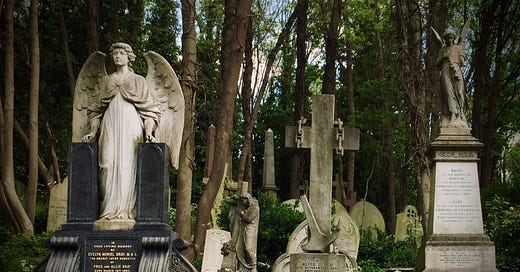



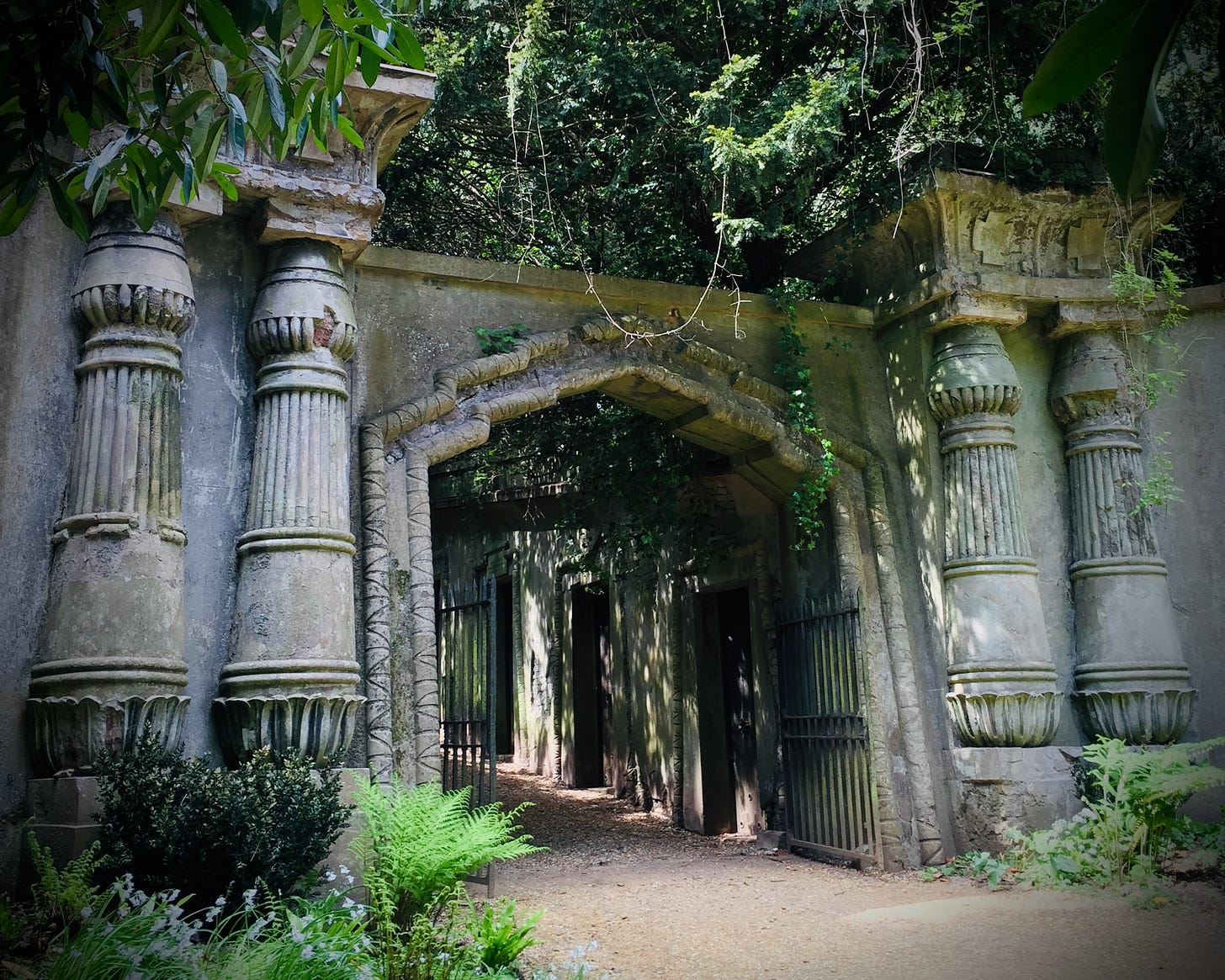
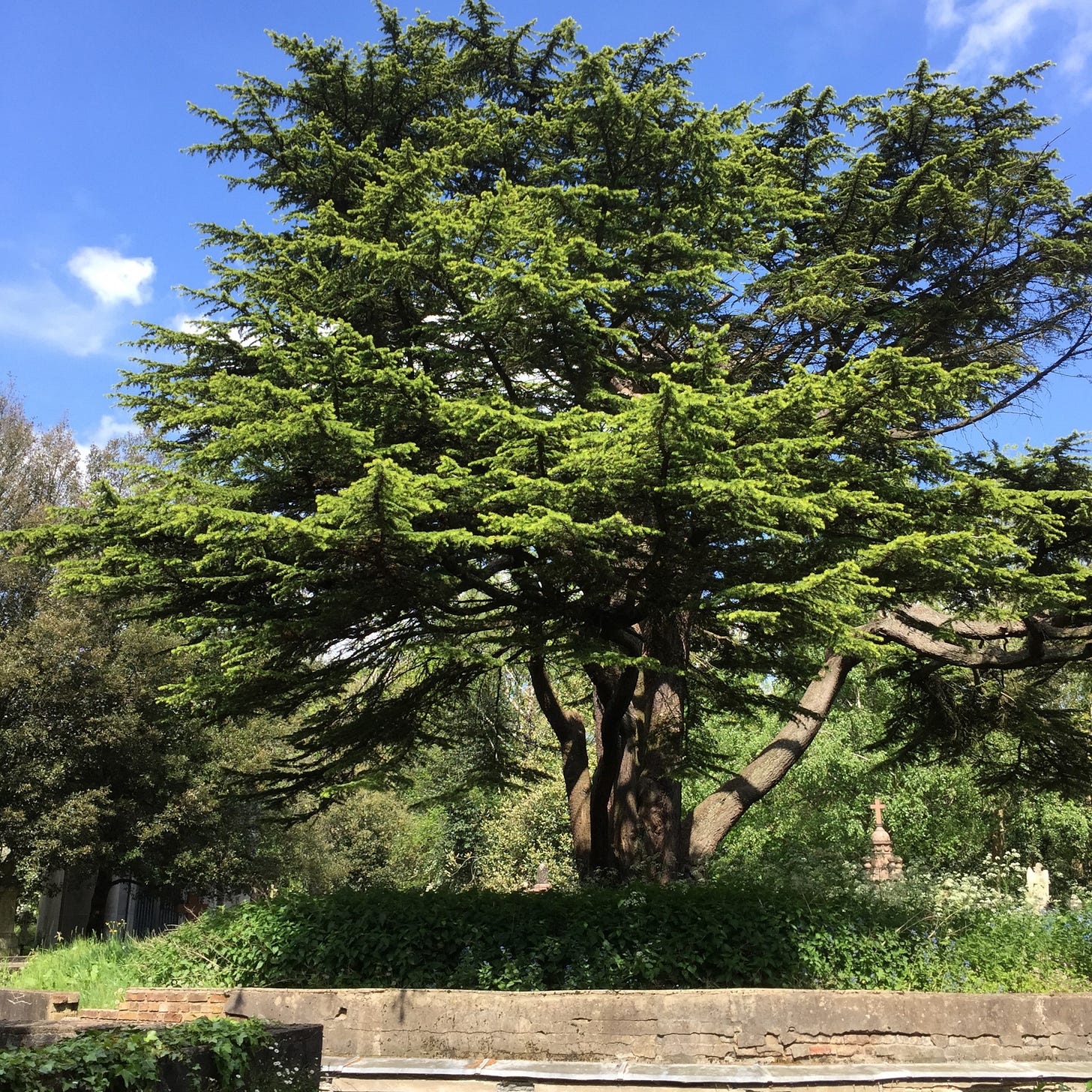
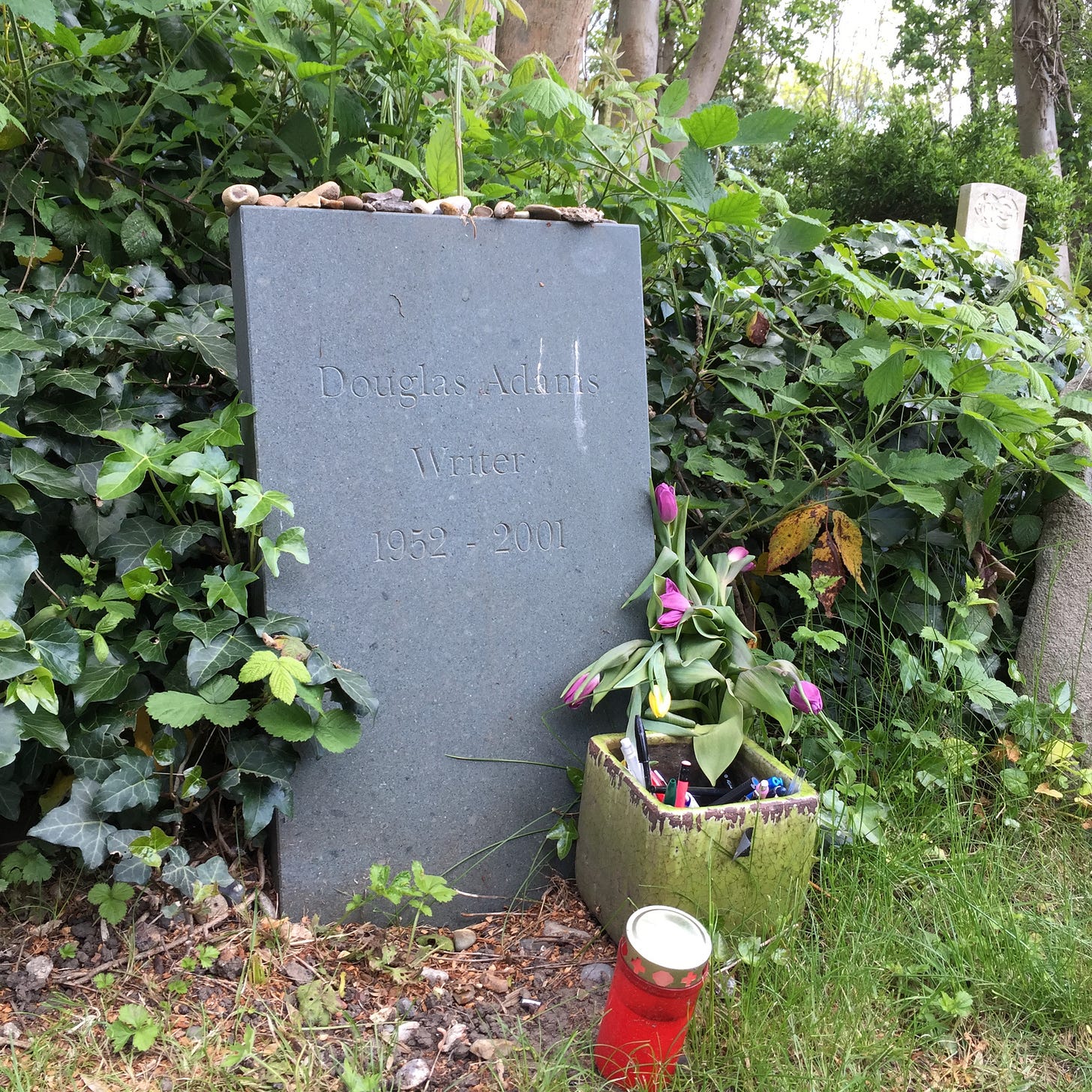
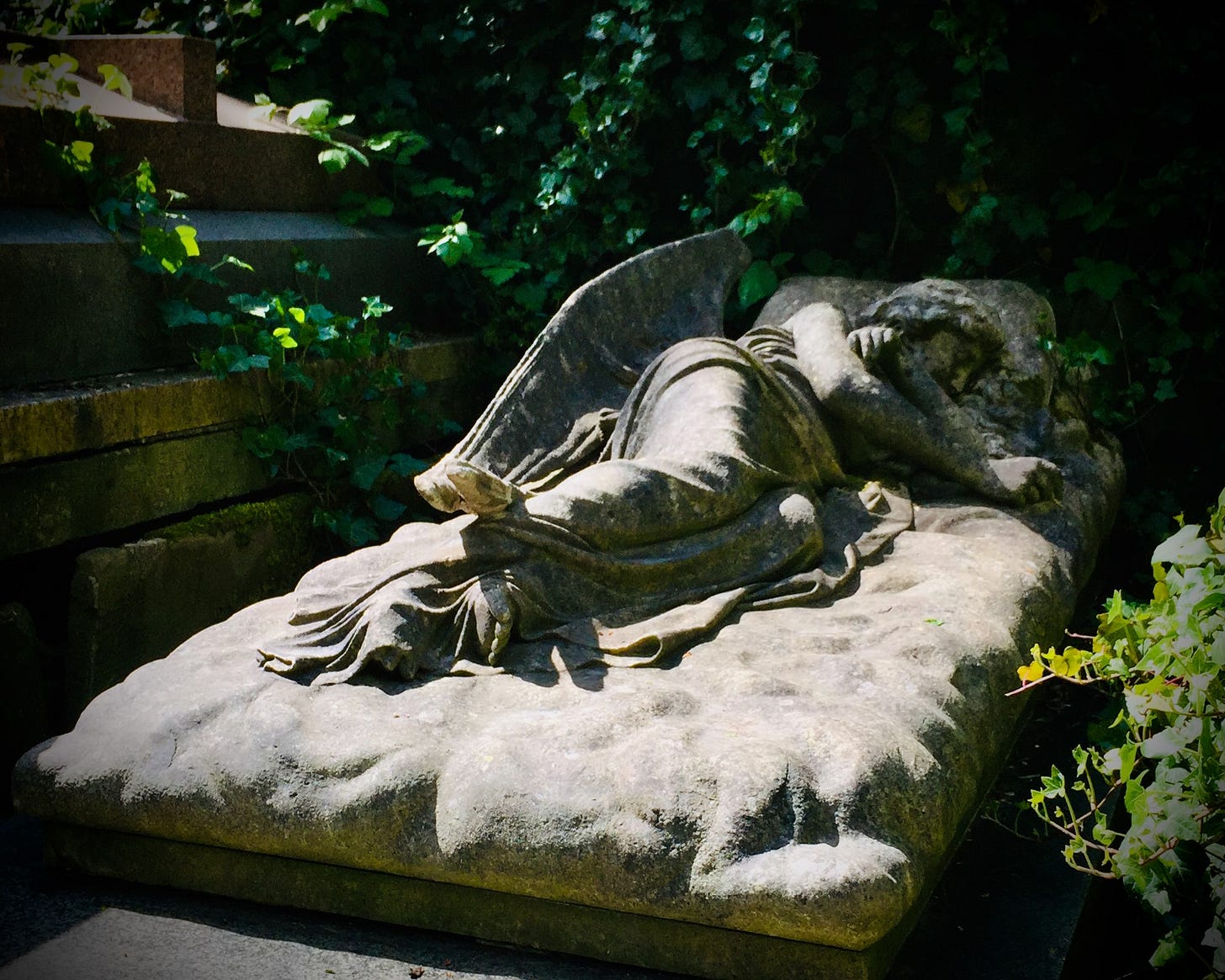


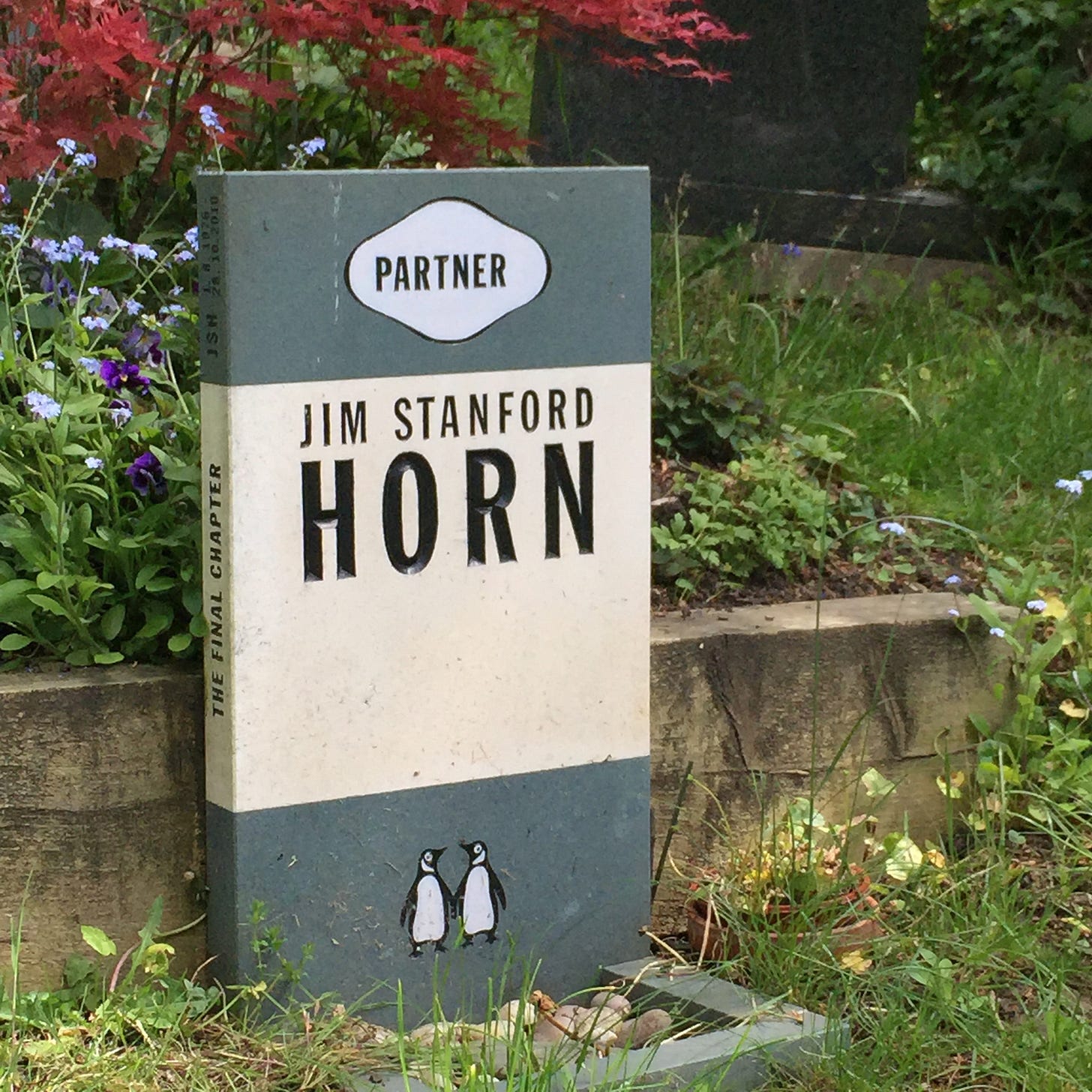
Enjoyed this post a lot! Visited Highgate about five years ago and this post brought me right back there. Thanks.